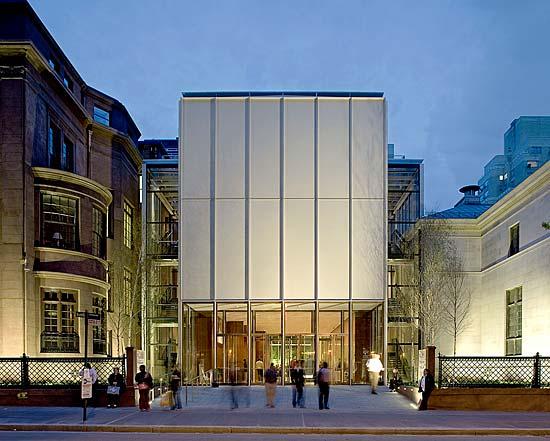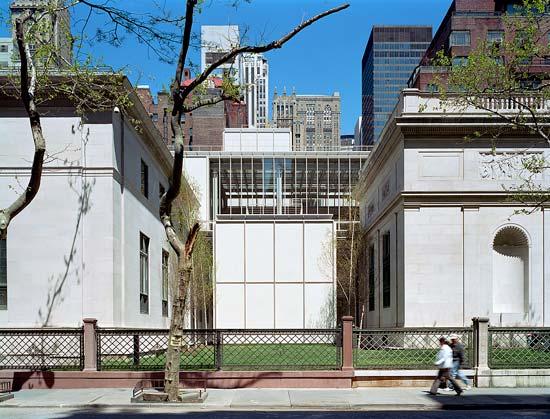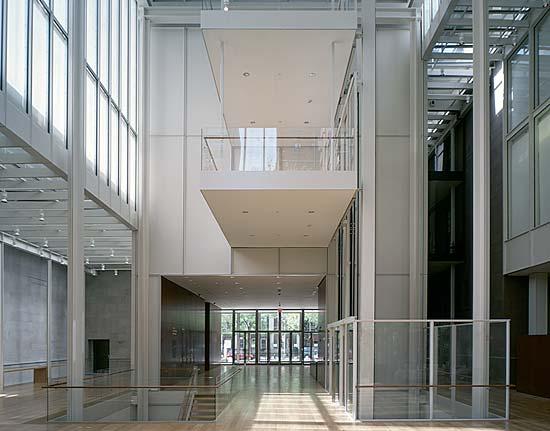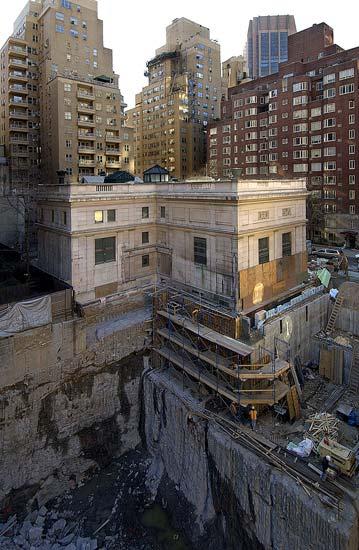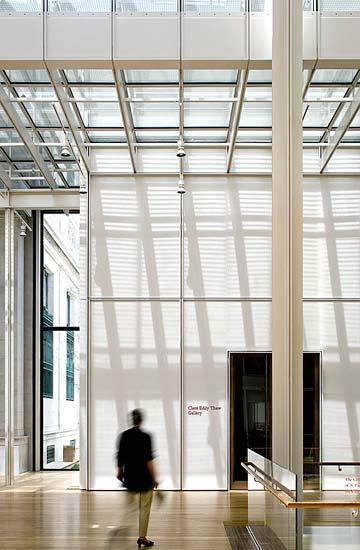The new design integrates three historical buildings—the original 1906 J. Pierpont Morgan's Library, designed by Charles McKim; the 1928 Annex building, designed by Benjamin Wistar Morris; and the mid-nineteenth-century Morgan House—with three intimately scaled pavilions to create an accessible and inviting setting. The three new pavilions face 36th Street, 37th Street, and Madison Avenue, with the largest centering the campus and providing the new entrance on Madison. The smallest contains a 20 x 20 x 20 foot "cube" gallery, the Clare Eddy Thaw Gallery, and was inspired by Renaissance chambers Piano encountered in Italy. It is an essential element in the interplay of the three new structures with the three historical buildings.
The pavilions are constructed of faceted steel panels and glass, with the steel coated in a rose-hued, off-white paint (a subtle nod to the Tennessee pink marble of the McKim building and Annex). The design also features high-transparency, low-iron glass and baffled roof systems for filtered natural light. The glass-enclosed Gilbert Court connects the buildings and seamlessly joins the old and new, providing many views both in and out of the 151,000-square-foot campus. In total, the Morgan expansion project adds about 75,000 square feet to the complex.
Four new galleries—the Engelhard Gallery, Morgan Stanley Gallery East, Morgan Stanley Gallery West, and the Clare Eddy Thaw Gallery—and interpretive installations create many more opportunities for adults, families, and schoolchildren to participate in programs devoted exclusively to the permanent collection. The additional gallery space allows the Morgan to exhibit more of its collections as well as host major loan exhibitions of master drawings, rare books, and original manuscripts. The new galleries are located in both the central pavilion and old reading room space in the Annex, effectively doubling the Morgan's overall exhibition space.
See more photographs of the construction phase
More on Expansion Design
With more than fifty percent of the square footage located below ground, the new buildings are modestly sized and respectful of the Morgan's traditional architecture and the surrounding neighborhood. Gilder Lehrman Hall, named in honor of Richard Gilder and Lewis E. Lehrman, is the Morgan's first performance hall and a significant new concert venue for New York. The hall, located below ground in the northeast corner of the site, was designed by Renzo Piano and acousticians Eckhard Kahle and David Harvey, and features fine cherrywood paneling on the walls and ceiling and a flexible stage that allows for the accommodation of up to 260 people.
A state-of-the-art storage facility for the collections is nestled deep into Manhattan schist and is equipped with modern climate control and security systems.
The Sherman Fairchild Reading Room maintains the subtle charm and intimacy of the former facility but is also outfitted with new technology and many more workstations to meet the needs of contemporary researchers. Naturally lit from above, its translucent roof structure enables scholars to examine the Morgan's holdings in the ideal environment for studying manuscripts and works on paper.
The Horace Goldsmith Foundation Education Center is a multipurpose room that accommodates classes, small lectures, and other educational offerings.
There are two new dining facilities—The Morgan Café, located in the central court, and The Morgan Dining Room, located in the former Morgan family dining room of the Morgan house.
The Morgan Shop has been expanded and is located in two restored period rooms on the first floor of the historic Morgan House.

